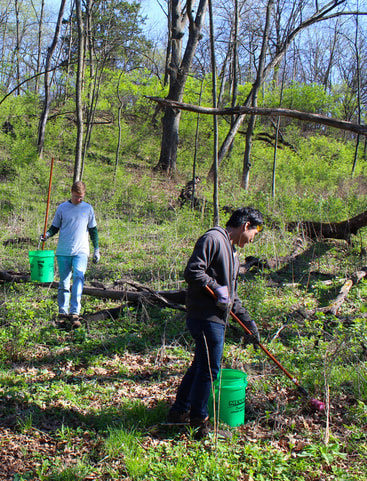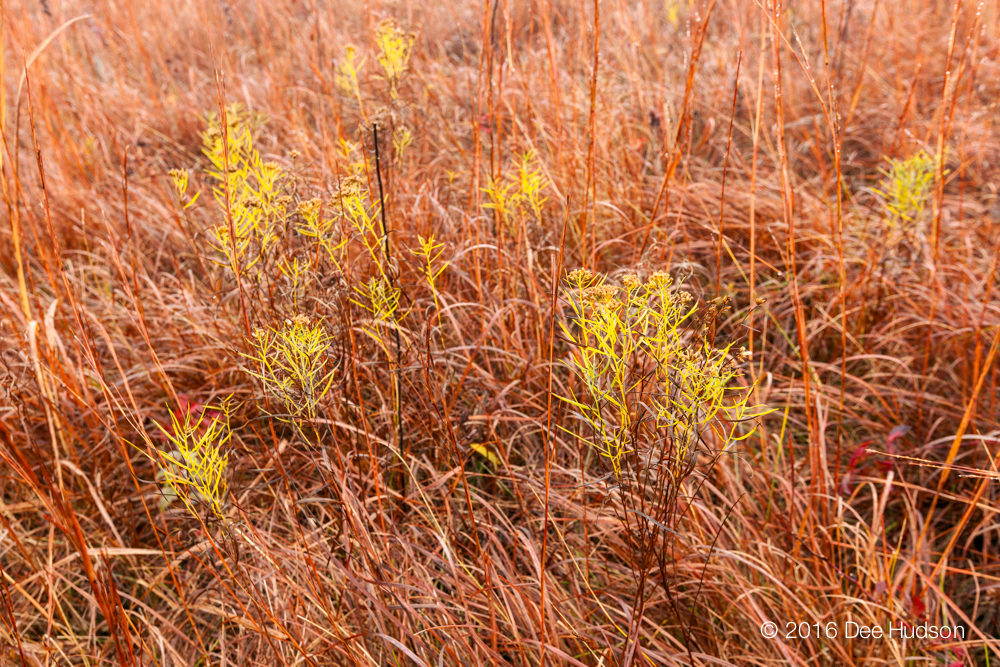|
In the fall I look forward to the incredible display from the native prairie grasses. Up to this point, the grasses have remained rather unobtrusive, but in the fall they step out of the background to claim our attention. Although I enjoy them all, the little bluestem grass is definitely my favorite. Little bluestem can be found throughout the prairie, but right now this grass is very noticeable if you to look the hills. Many of Nachusa’s knobs and hills are blanketed in an orange–red, and that color is from the . . . little bluestem grass!! In addition, throughout the winter, the grass will retain this energetic color and stand out beautifully in the snow. As the autumn winds blow, the little bluestem grass undulates like waves in the ocean, as seen in the photo above in the upper left. It is mesmerizing to watch it ripple across a vast expanse. The view is from the top of Fameflower Knob in early fall (notice the leaves still on the trees). As a photographer, I love to use little bluestem as a backdrop for the goldenrods and asters that bloom in the fall. Then, as the season progresses, the grass creates a wonderful texture and contrasting color for the changing leaves of many other forbs. It is surprising to view the seeds up close through a macro lens. Look at all that white feathery fluff decorating the seedstalk! So intricate with so many fine hairs. Come visit Nachusa and enjoy a late fall hike through the grasses. I recommend the Clear Creek Knolls hike, with a climb to the top of Fameflower Knob. The hike trailhead is accessible from the small parking lot on Lowden Road, just south of Flagg Road or 1.4 miles north of the visitor kiosk. Once you arrive at the base of the hill, there is no path, so make your own! Just avoid walking on top of the sandstone, for it crumbles easily. Give the short climb a try and if you do, leave us a comment on this blog about your adventure!
Today’s author is Dee Hudson, a photographer and volunteer for Nachusa Grasslands. To see more prairie images, visit her website at www.deehudsonphotography.com.
2 Comments
By Mark Jordan It is easy to spot and identify in late autumn. The tall deciduous trees, the oaks, the hickories and others, have but a few brown leaves still clinging to their skeleton frames. Below, on shorter plants, abundant leaves remain green. A drive in the country reveals this late season green plant growing at the edge of a woodlot, deep in a forest or in abandoned fields. It is in the fall that its abundance becomes most visible. It is exotic and invasive bush Honeysuckle.  Dense Honeysuckle growth Dense Honeysuckle growth Nonnative Honeysuckles such as Amur Honeysuckle, Showy Fly Honeysuckle, Common Fly Honeysuckle and others were introduced into the United States from Eurasia more than 100 years ago. They were brought into new habitats for ornamental reasons, for erosion control and for wildlife cover. In the absence of repeated fires and in grazed and disturbed wooded areas the exotic Honeysuckles have reproduced rapidly and spread widely.  There are woodland and savanna areas now in Nachusa Grasslands where the Honeysuckle has become abundant over many decades and is disruptive to the native ecosystems. These multi-stemmed bushes can grow up to twelve feet tall and form very thick shrub layers that prevent the growth of native species by decreasing the amount of light reaching the forest floor and by using up nutrients and water in the soil. Honeysuckles are considered an allelopathic species as they release chemicals into the soil that inhibit the growth of native species. Birds that may build nests in Honeysuckle are more susceptible to predation because the Honeysuckle branches are nearer the ground than native bushes. The abundant berries, while high in carbohydrates, do not produce the fats and nutrients needed by migrating birds in the fall. I have been a steward of the East Tellabs Unit at Nachusa Grasslands since 2011. With the help of many volunteers, other stewards and the Nachusa crew, we have cut and treated thousands of Honeysuckle plants of all sizes. It is rewarding to use a pair of loppers or a saw to cut a plant near its base and treat the stump with a chemical to kill the Honeysuckle and prevent resprouting. The forest floor is exposed and sunlight may reach it for the first time in years. Other methods of attacking this invasive plant include chemically spraying the leaves, applying chemicals to the base of the plant and seasonal fires.  Painting the stems of Honeysuckle Painting the stems of Honeysuckle The work to decrease the Honeysuckles continues. A few hours working among the Honeysuckle can leave one tired, sweaty, sore, scratched and covered in burrs. Yet the tired and sore will go home feeling proud for doing a necessary task that makes a difference in the diversity and ecology of the woodlands and savannas. Each Saturday a Nachusa steward leads a volunteer workday. You might collect seeds, you might pull weeds, you might pile deadfall, or you might cut, treat, stack and burn Honeysuckle.  Mark Jordan Mark Jordan Text and Photography by Tellabs Steward Mark Jordan |
Blog CoordinatorDee Hudson
I am a nature photographer, a freelance graphic designer, and steward at Nachusa's Thelma Carpenter Prairie. I have taken photos for Nachusa since 2012. EditorJames Higby
I have been a high school French teacher, registered piano technician, and librarian. In retirement I am a volunteer historian at Lee County Historical and Genealogical Society. Categories
All
Archives
January 2024
|
CONNECT WITH US |
|










 RSS Feed
RSS Feed